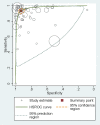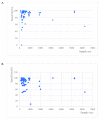High value of rapid diagnostic tests to diagnose malaria within children: A systematic review and meta-analysis
- PMID: 32373330
- PMCID: PMC7182354
- DOI: 10.7189/jogh.10.010411
High value of rapid diagnostic tests to diagnose malaria within children: A systematic review and meta-analysis
Abstract
Background: Children aged under five years accounted for 61% of all malaria deaths worldwide in 2017, and quicker differential diagnosis of malaria fever is vital for them. Rapid diagnostic tests (RDTs) are strips to detect.
Plasmodium: specific antigens promptly and are helpful in resource-limited areas. Thus, our aim is to assess the diagnostic accuracy of RDTs for malaria in children against the gold standard.
Methods: MEDLINE, Web of Science, EMBASE, Cochrane Library, the China National Knowledge Infrastructure, Wanfang, and Sinomed databases were systematically searched on August 23, 2019. Studies that compared RDTs with microscopy or polymerase chain reaction in malaria diagnoses for children were eligible. Relevant data were extracted. The quality of studies was evaluated using the revised Quality Assessment of Diagnostic Accuracy Studies instrument. Meta-analyses were carried out to calculate the pooled estimates and 95% confidence intervals of sensitivity and specificity.
Results: 51 articles were included. For diagnostic accuracy, the pooled estimates of the sensitivity and specificity of RDTs were 0.93 (95% confidence interval (CI) = 0.90, 0.95) and 0.93 (95% CI = 0.90, 0.96) respectively. Studies were highly heterogeneous, and subgroup analyses showed that the application of RDTs in high malaria transmission areas had higher sensitivity but lower specificity than those in low-to-moderate areas.
Conclusions: RDTs have high accuracy for malaria diagnosis in children, and this characteristic is more prominent in high transmission areas. As they also have the advantages of rapid-detection, are easy-to-use, and can be cost-effective, it is recommended that the wider usage of RDTs should be promoted, especially in resource-limited areas. Further research is required to assess their performance in WHO South-East Asia and Americas Region.
Copyright © 2020 by the Journal of Global Health. All rights reserved.
Conflict of interest statement
Competing interests: The authors completed the ICMJE Unified Competing Interest form (available upon request from the corresponding author), and declare no conflicts of interest.
Figures







Similar articles
-
Multi-method assessment of patients with febrile illness reveals over-diagnosis of malaria in rural Uganda.Malar J. 2016 Sep 7;15(1):460. doi: 10.1186/s12936-016-1502-4. Malar J. 2016. PMID: 27604542 Free PMC article.
-
Performance of rapid diagnostic tests, microscopy, loop-mediated isothermal amplification (LAMP) and PCR for malaria diagnosis in Ethiopia: a systematic review and meta-analysis.Malar J. 2021 Sep 27;20(1):384. doi: 10.1186/s12936-021-03923-8. Malar J. 2021. PMID: 34579729 Free PMC article.
-
Field evaluation of diagnostic performance of malaria rapid diagnostic tests in western Kenya.Malar J. 2016 Sep 7;15(1):456. doi: 10.1186/s12936-016-1508-y. Malar J. 2016. PMID: 27604888 Free PMC article.
-
Management of uncomplicated malaria in febrile under five-year-old children by community health workers in Madagascar: reliability of malaria rapid diagnostic tests.Malar J. 2012 Mar 25;11:85. doi: 10.1186/1475-2875-11-85. Malar J. 2012. PMID: 22443344 Free PMC article. Clinical Trial.
-
A Systematic Review: Performance of Rapid Diagnostic Tests for the Detection of Plasmodium knowlesi, Plasmodium malariae, and Plasmodium ovale Monoinfections in Human Blood.J Infect Dis. 2018 Jun 20;218(2):265-276. doi: 10.1093/infdis/jiy150. J Infect Dis. 2018. PMID: 29554284 Free PMC article.
Cited by
-
Comparative evaluation of the diagnostic accuracies of four different malaria rapid diagnostic test kits available in Ghana.PLoS One. 2024 May 7;19(5):e0302840. doi: 10.1371/journal.pone.0302840. eCollection 2024. PLoS One. 2024. PMID: 38713676 Free PMC article.
-
Diagnostic performance of rapid diagnostic test, light microscopy and polymerase chain reaction during mass survey conducted in low and high malaria-endemic areas from two North-Eastern states of India.Parasitol Res. 2021 Jun;120(6):2251-2261. doi: 10.1007/s00436-021-07125-8. Epub 2021 Mar 27. Parasitol Res. 2021. PMID: 33772349 Free PMC article. Clinical Trial.
-
How socioeconomic status affected the access to health facilities and malaria diagnosis in children under five years: findings from 19 sub-Saharan African countries.Infect Dis Poverty. 2023 Apr 6;12(1):29. doi: 10.1186/s40249-023-01075-2. Infect Dis Poverty. 2023. PMID: 37024969 Free PMC article.
-
Cost-effectiveness analysis of malaria rapid diagnostic test in the elimination setting.Infect Dis Poverty. 2020 Sep 29;9(1):135. doi: 10.1186/s40249-020-00745-9. Infect Dis Poverty. 2020. PMID: 32993762 Free PMC article.
-
Evaluating the implementation of rapid diagnostic tests in a malaria elimination setting.Infect Dis Poverty. 2020 Jul 8;9(1):84. doi: 10.1186/s40249-020-00702-6. Infect Dis Poverty. 2020. PMID: 32641123 Free PMC article.
References
-
- World Health Organization. Global Technical Strategy for Malaria 2016-2030. Geneva: World Health Organization; 2015.
-
- World Health Organization. World malaria report 2018. Geneva: World Health Organization; 2018.
-
- World Health Organization. Guidelines for the treatment of malaria-Third edition. Geneva: World Health Organization; 2015.
Publication types
MeSH terms
LinkOut - more resources
Full Text Sources
Medical
Research Materials
